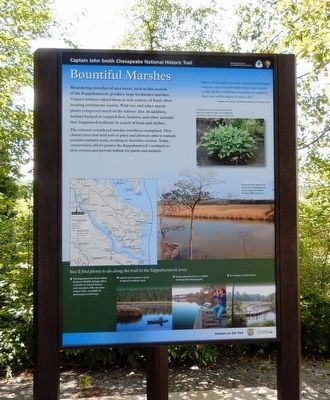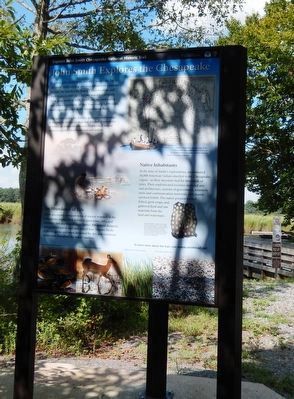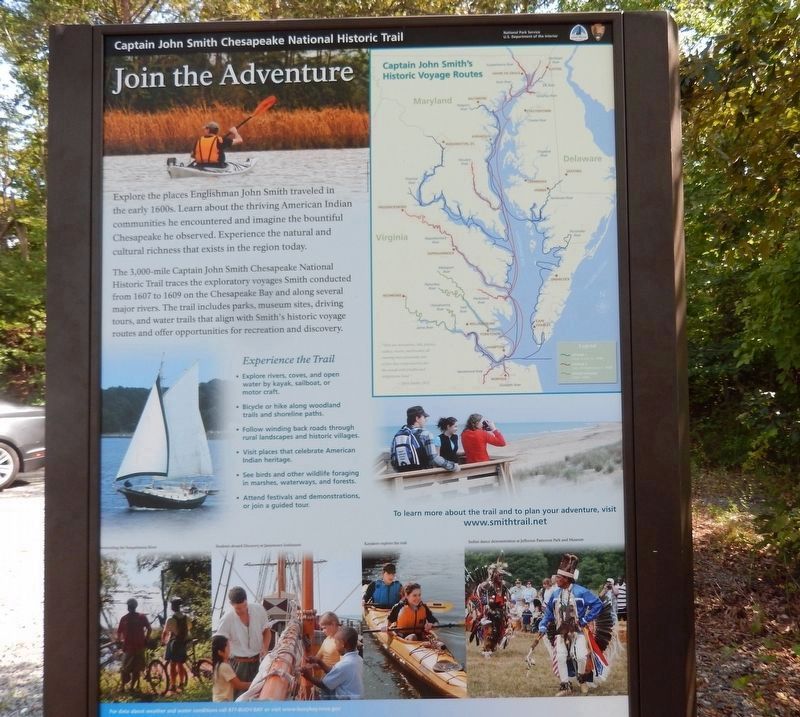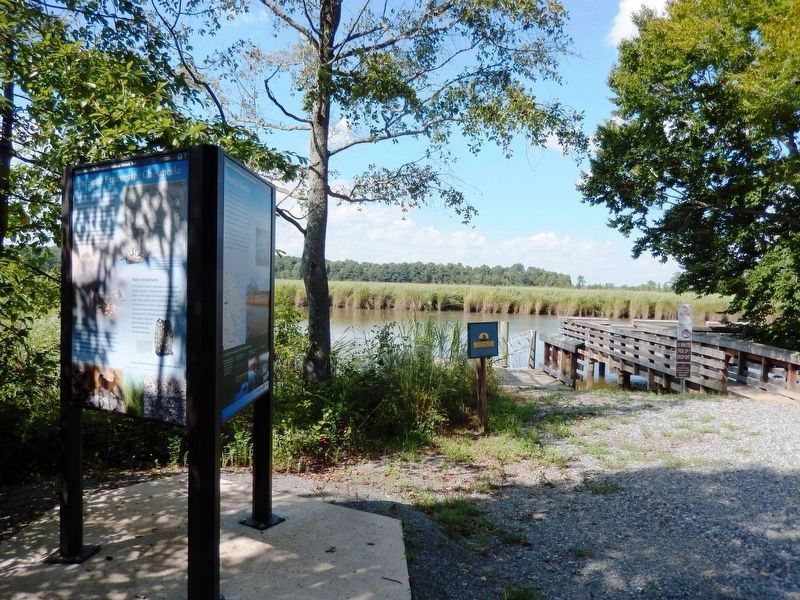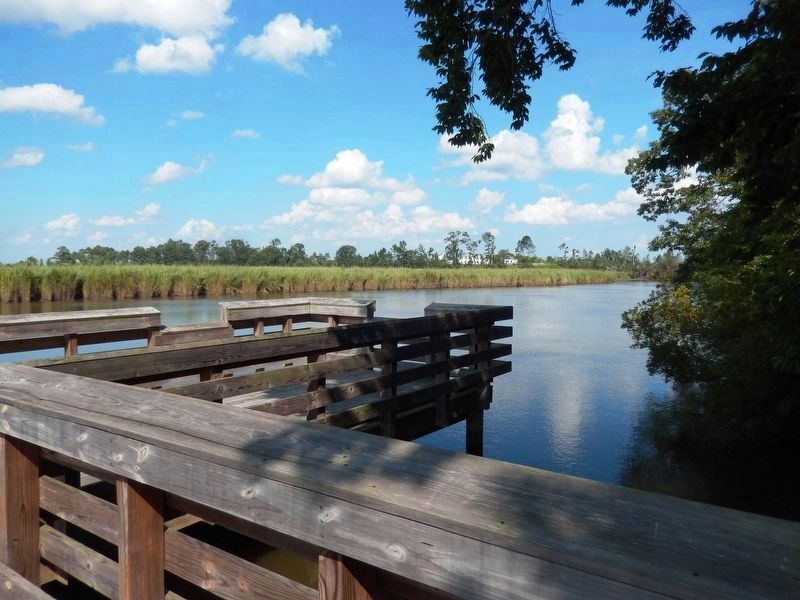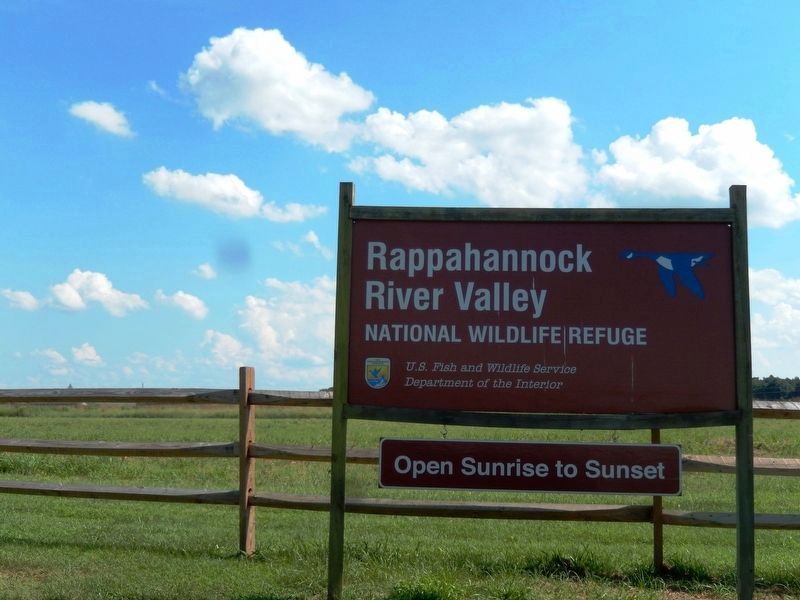Tappahannock in Essex County, Virginia — The American South (Mid-Atlantic)
Bountiful Marshes
Captain John Smith Chesapeake National Historic Trail
— National Park Service, U.S. Department of the Interior —
(panel 1)
Bountiful Marshes
Meandering stretches of area rivers, such as this section of the Rappahannock, produce large freshwater marshes. Virginia Indians valued them as rich sources of food, often locating settlements nearby. Wild rice and other marsh plants comprised much of the natives’ diet. In addition Indians hunted or trapped deer, beavers, and other animals that frequented wetlands in search of food and shelter.
The colonists considered marshes worthless swampland. They cleared trees that held soils in place and allowed cattle to trample sensitive wetland areas, resulting in shoreline erosion. Today, conservation efforts protect the Rappahannock’s wetlands to slow erosion and provide habitat for plants and animals.
“Others would gather as much tockwhogh (Tuckahoe) roots in a days as would make them bread a week, so that off those wild fruits and what we caught we lived very well in regard of such a diet.”
-Captain John Smith, The General History of Virginia, 1624.
(captions)
Tuckahoe (or arrow arum), which Indians dug out of mud in winder, was a substitute starch when there was no grain or corn left.
Broad marshes characterize much of the Rappahannock River and provide habitat for many different species.
(sidebar)
You’ll find plenty to do along the trail in the Tappahannock area:
• The Rappahannock River Valley National Wildlife Refuge offers a wealth of natural beauty and recreation. Hike its many nature trails, or paddle its picturesque waterways.
• Launch your kayak or canoe at Mount Landing Creek.
• Enjoy opportunities for wildlife viewing and photography.
• Go fishing at Wilna Pond.
(panel 2)
John Smith Explores the Chesapeake
Captain John Smith explored the Chesapeake Bay in the early 1600s seeking precious metals and a passage to Asia. He traveled the James, Chickahominy, and York rivers in 1607, and led two major expeditions from Jamestown in 1608. Smith and his crew sailed and rowed a primitive 30-foot boat nearly 3,000 miles, reaching as far north as the Susquehanna River.
Although Smith did not discover gold, or a river to the Pacific, his precise map and detailed observations of American Indian societies and the abundant natural resources guided future explorers and settlers.
Native Inhabitants
At the time of Smith's explorations, an estimated 50,000 American Indians dwelled in the Chesapeake region—as their ancestors had for thousands of years. Their sophisticated societies included arts and architecture, systems of government, extensive trade and communication networks, and shared spiritual beliefs. The native people hunted, fished, grew crops, and gathered food and raw materials from the land and waterways.
An Abundance of Life
Smith discovered a treasure trove of natural wonders in the Chesapeake region: thick forests of giant pines, oaks, and hickories; vast marshlands, huge turtles, 800-pound sturgeon, and great schools of shad and striped bass. Massive flocks of ducks, geese, and swans darkened the sky; and enormous oyster reefs rose above the water's surface.
To learn more about the trail visit www.smithtrail.net
(captions)
Smith’s remarkably accurate map of the Chesapeake Bay (published in 1612), and his spirited written accounts of a lush landscape inspired European migration.
Decorative shells-such as those found on this ceremonial robe-were valuable in the American Indian’s trading network that extended for hundreds of miles. This robe (which may have belonged to paramount chief Powhatan) was crafted from four elk skins and adorned with more than 17,000 shells.
Wood ducks and other waterfowl flourished
The forests and lowlands teemed with deer
Cattails grew thick in pristine marshes
Flocks of geese filled the sky
(panel 3)
Join the Adventure
Explore the places Englishman John Smith traveled in the early 1600s. Learn about the thriving American Indian communities he encountered and imagine the bountiful Chesapeake he observed. Experience the natural and cultural richness that exists in the region today.
The 3,000-mile Captain John Smith Chesapeake National Historic Trail traces the exploratory voyages Smith conducted from 1607 to 1609 on the Chesapeake Bay and along several major rivers. The trail includes parks, museum sites, driving tours, and water trails that align with Smith's historic voyage routes and offer opportunities for recreation and discovery.
Experience the Trail
• Explore rivers, coves, and open water by kayak, sailboat, or motor craft.
• Bicycle or hike along woodland trails and shoreline paths.
• Follow winding back roads through rural landscapes and historic villages.
• Visit places that celebrate American Indian heritage.
• See birds and other wildlife foraging in marshes, waterways, and forests.
• Attend festivals and demonstrations, or join a guided tour.
To learn more about the trail and to plan your adventure, visit
www.smithtrail.net
(captions)
Captain John Smith’s Historic Voyage Routes
“Here are mountains, hils, plaines, valleys, rivers, and brookes all running most pleasantly into a faire Bay compassed but for the mouth with fruitful and delightsome land.”
– John Smith, 1612
Overlooking the Susquehanna River
Students aboard Discovery at Jamestown Settlement
Kayakers explore the trail
Indian dance demonstration at Jefferson Patterson Park and Monument
Erected 2014 by National Park Service, U.S. Department of the Interior.
Topics and series. This historical marker is listed in these topic lists: Colonial Era • Exploration • Native Americans • Settlements & Settlers • Waterways & Vessels. In addition, it is included in the Captain John Smith Chesapeake National Historic Trail series list. A significant historical year for this entry is 1607.
Location. 37° 56.823′ N, 76° 53.477′ W. Marker is in Tappahannock, Virginia, in Essex County. Marker can be reached from Tidewater Trail (U.S. 17) one mile north of Airport Road (Virginia Route 627), on the left when traveling north. Marker is located at the boat landing in the Rappahannock River Valley National Wildlife Refuge. Touch for map. Marker is in this post office area: Tappahannock VA 22560, United States of America. Touch for directions.
Other nearby markers. At least 8 other markers are within 2 miles of this marker, measured as the crow flies. Rivers of Grass (approx. half a mile away); National Wildlife System (approx. 0.6 miles away); Hutchinson Tract (approx. 0.6 miles away); Pollinators (approx. 0.6 miles away); Rappahannock Indian Migration (approx. 1.1 miles away); Toppahanock Indian Village (approx. 1.1 miles away); William Moore Tidewater Musician (approx. 2 miles away); 1728 Courthouse (approx. 2.1 miles away). Touch for a list and map of all markers in Tappahannock.
Also see . . .
1. Captain John Smith Chesapeake National Historic Trail. National Park Service (Submitted on August 25, 2016.)
2. Rappahannock River Valley National Wildlife Refuge. U.S. Fish and Wildlife Service (Submitted on August 25, 2016.)
Credits. This page was last revised on June 12, 2020. It was originally submitted on August 23, 2016, by Don Morfe of Baltimore, Maryland. This page has been viewed 386 times since then and 10 times this year. Photos: 1, 2, 3, 4, 5, 6. submitted on August 23, 2016, by Don Morfe of Baltimore, Maryland. • Bernard Fisher was the editor who published this page.
